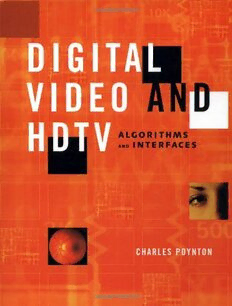Table Of ContentDigital Video and HDTV
Algorithms and Interfaces
The Morgan Kaufmann Series in Computer Graphics and Geometric Modeling
Series Editor: Brian A. Barsky, University of California, Berkeley
Digital Video and HDTV Algorithms Andrew Glassner’s Notebook:
and Interfaces Recreational Computer Graphics
Charles Poynton Andrew S. Glassner
Texturing & Modeling: AProcedural Warping and Morphing of Graphical
Approach, Third Edition Objects
David S. Ebert, F. Kenton Musgrave, Jonas Gomes, Lucia Darsa, Bruno
Darwyn Peachey, Ken Perlin, and Costa, and Luiz Velho
Steven Worley
Jim Blinn's Corner: Dirty Pixels
Geometric Tools for Computer Graphics Jim Blinn
Philip Schneider and David Eberly
Rendering with Radiance: The Art
Understanding Virtual Reality: and Science of Lighting Visualization
Interface, Application, and Design Greg Ward Larson and Rob Shakes-
William Sherman and Alan Craig peare
Jim Blinn's Corner: Notation, Introduction to Implicit Surfaces
Notation, Notation Edited by Jules Bloomenthal
Jim Blinn
Jim Blinn’s Corner: ATrip Down
Level of Detail for 3D Graphics the Graphics Pipeline
David Luebke, Martin Reddy, Jim Blinn
Jonathan D. Cohen, Amitabh
Interactive Curves and Surfaces:
Varshney, Benjamin Watson, and
AMultimedia Tutorial on CAGD
Robert Huebner
Alyn Rockwood and Peter Chambers
Pyramid Algorithms: A Dynamic
Wavelets for Computer Graphics:
Programming Approach to Curves and
Theory and Applications
Surfaces for Geometric Modeling
Eric J. Stollnitz, Tony D. DeRose,
Ron Goldman
and David H. Salesin
Non-Photorealistic Computer Graphics:
Principles of Digital Image Synthesis
Modeling, Rendering, and Animation
Andrew S. Glassner
Thomas Strothotte and Stefan
Schlechtweg Radiosity & Global Illumination
François X. Sillion and Claude Puech
Curves and Surfaces for CAGD:
APractical Guide, Fifth Edition Knotty: AB-Spline Visualization
Gerald Farin Program
Jonathan Yen
Subdivision Methods for Geometric
Design: AConstructive Approach User Interface Management Systems:
Joe Warren and Henrik Weimer Models and Algorithms
Dan R. Olsen, Jr.
Computer Animation: Algorithms
and Techniques Making Them Move: Mechanics,
Rick Parent Control, and Animation of Articulated
Figures
The Computer Animator’s Technical
Edited by Norman I. Badler, Brian A.
Handbook
Barsky, and David Zeltzer
Lynn Pocock and Judson Rosebush
Geometric and Solid Modeling:
Advanced RenderMan: Creating CGI
An Introduction
for Motion Pictures
Christoph M. Hoffmann
Anthony A. Apodaca and Larry Gritz
An Introduction to Splines for Use
Curves and Surfaces in Geometric
in Computer Graphics and Geometric
Modeling: Theory and Algorithms
Modeling
Jean Gallier
Richard H. Bartels, John C. Beatty,
and Brian A. Barsky
Publishing Director: Diane Cerra
Publishing Services Manager: Edward Wade
Production Editor: Howard Severson
Design, illustration, and composition: Charles Poynton
Editorial Coordinator: Mona Buehler
Cover Design: Frances Baca
Copyeditor: Robert Fiske
Proofreader: Sarah Burgundy
Printer: The Maple-Vail Book Manufacturing Group
Cover images: Close-up of woman/Eyewire; Circuit connection/Artville;
Medical prespectives/Picture Quest
Designations used by companies to distinguish their products are often claimed
as trademarks or registered trademarks. In all instances in which Morgan
Kaufmann Publishers is aware of a claim, the product names appear in initial
capital or all capital letters. Readers, however, should contact the appropriate
companies for more complete information regarding trademarks and registration.
Morgan Kaufmann Publishers
An imprint of Elsevier Science
340 Pine Street, Sixth Floor
San Francisco, CA 94104-3205
www.mkp.com
Copyright 2003 by Elsevier Science (USA). All rights reserved.
Printed in the United States of America
2007 2006 2005 2004 2003 5 4 3 2 1
No part of this publication may be reproduced, stored in aretrieval system, or
transmitted in any form or by any means– electronic, mechanical, photocopying,
scanning or otherwise– without prior written permission of the Publisher.
Library of Congress Control Number: 2002115312
ISBN: 1-55860-792-7
This book is printed on acid-free paper.
Dedication
In memory of my mother,
Marjorie Johnston
1926—2002
and
to Quinn and Georgia,
and the new family tree
Digital Video and HDTV
Algorithms and Interfaces
Charles Poynton
Part 1
Introduction
1 Raster images 3
2 Quantization 17
Brightness contrast
3 and controls 25
4 Raster images in computing 31
5 Image structure 43
6 Raster scanning 51
7 Resolution 65
8 Constant luminance 75
9 Rendering intent 81
10 Introduction to luma and chroma 87
11 Introduction to component SDTV 95
12 Introduction to composite NTSC and PAL 103
13 Introduction to HDTV 111
14 Introduction to video compression 117
15 Digital video interfaces 127
1
Raster images 1
This chapter introduces the basic features of the pixel
array. Iexplain how the pixel array is digitized from the
image plane, how pixel values are related to brightness
and color, and why most imaging systems use pixel
values that are nonlinearly related to light intensity.
Imaging
In human vision, the three-dimensional world is imaged
by the lens of the eye onto the retina, which is popu-
lated with photoreceptor cells that respond to light
having wavelengths ranging from about 400 nm to
700 nm. In video and in film, we build acamera having
alens and aphotosensitive device, to mimic how the
world is perceived by vision. Although the shape of the
retina is roughly asection of asphere, it is topologi-
cally two dimensional. In acamera, for practical
reasons, we employ aflat image plane, sketched in
Figure 1.1 below, instead of asection of asphere. Image
science concerns analyzing the continuous distribution
of optical power that is incident on the image plane.
Figure 1.1 Scene,
lens, image plane
3

